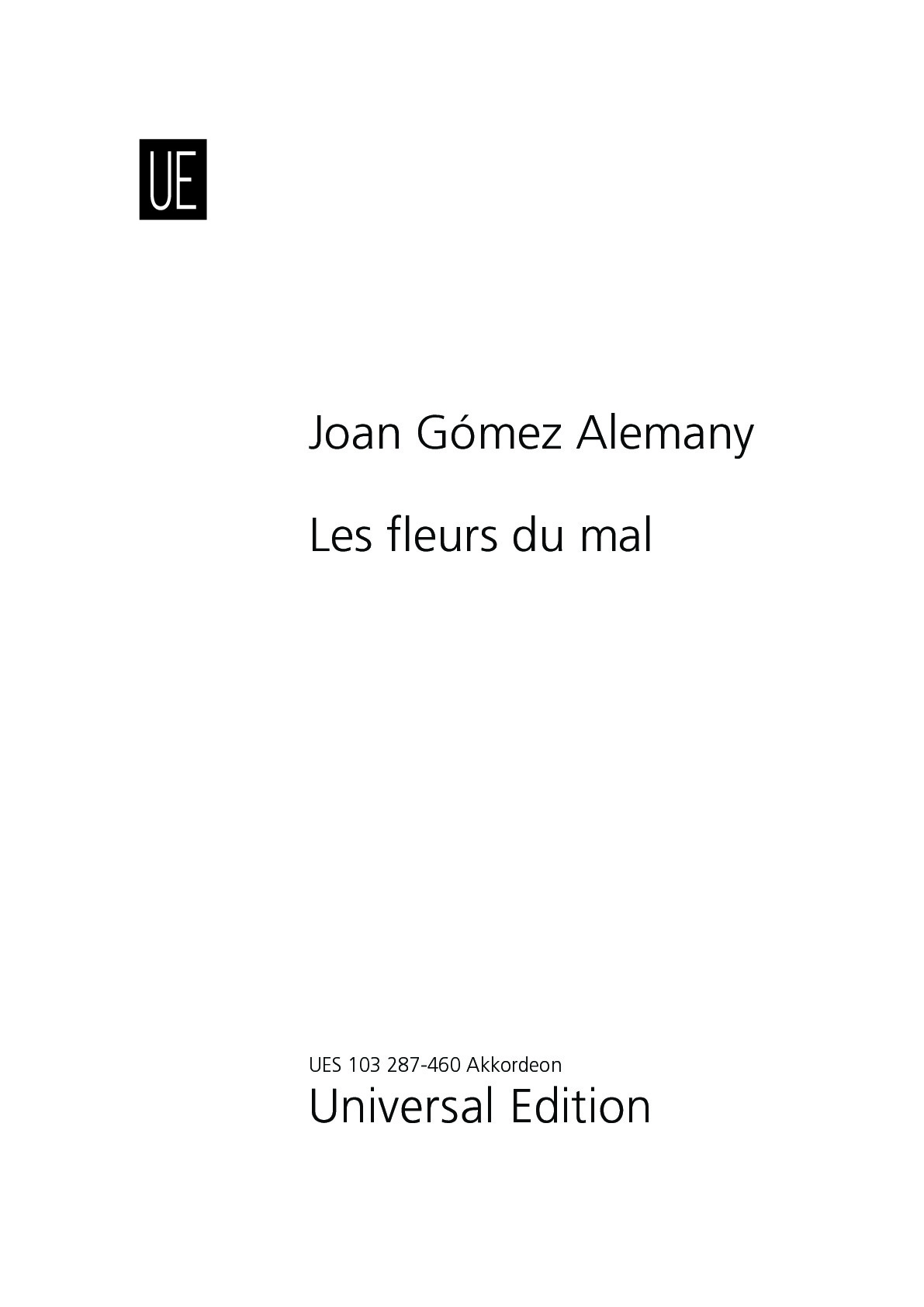.png)
Digital edition
immediately available as PDF
€14.95
Payments:
Shipping:
Joan Gómez Alemany
Akkordeon (Les fleurs du mal )
UES103287-460
Type: Stimme
Format: 210 x 297 mm
Pages: 12
Digital edition
immediately available as PDF
€14.95
Payments:
Shipping:
Description
Les fleurs du mal was commissioned by Aer Duo and premiered the 18.06.2021 in Mostra Sonora Sueca Contemporary Music Festival (Spain).
PROGRAM NOTE: Coincidence or not, this composition began to be written just after I finished reading The Flowers of Evil by Baudelaire for the second time (the first time was in 2013). This long collection of poems and great work that was developed by the author over a long period of time, conditions this composition in various aspects. The crazy comparison between the collection of poems and the composition inspired by it is not trivial. There is an absurd and strong imbalance between a text written for several years, which summarizes an entire "credo and ideal" of the author; against a "modest and simple" composition within the chamber genre, for two instruments (as two are a book and a reader), conceived and written over two months. The score was finished on the retrogradable 03-21-2021 (it's true, even if it seems like fiction). This tense and fractured comparison "can be heard in the sounds of the work." In music, the use of poems is almost always for voice (song-lied, opera, oratorio, etc.). Without this instrument, the poem is impossible to make explicit. That the voice does not exist here, has been a consciously thought-out strategy and the way in which the poems are cited is multiple and complex. The poem in turn inspires and limits the sonorous, but also the sonorous chooses a posteriori with which poem it can be related. The chamber composition is written as a contradiction, turning out to be like a kind of opera without libretto or orchestra, or a song without voice or piano. Not only Baudelaire is cited, but also some famous composers (Berg, Fauré, Debussy and Caplet) who have made use of his poems (citing both, his music and his quoted poems). But unlike them, who resort to the voice by setting entire poems of Les Fleurs du mal to music, in the case of our work, the fragmentation and dissolution of both, the poems and the quotations of the composers who quote them, has been a main resource to create this composition. The rupture of both poetic and sonorous unity causes a detrital waste in decomposed fragments. In reference to the sound, there is some complete melody (the most cited resource within the quotes), but also little-cited material, such as isolated harmonies, accompaniments or structures. Quotations are thus diluted and transformed with the unquoted source material. For this reason, the quote is a highly structural and organizing element, not a decorative resource that is foreign to the work. Self-citation is also used, with its idea of splitting the self into another self, to emphasize the coherence of what seems scattered and chaotic. In the self-citation some techniques are cited (no specific sound material) from another duo that we wrote a long time ago (specifically Azhan). Overwriting in this sense ends up being a compositional technique.
Networks that are woven in the form of a spiral between the different elements used, thanks to the idea of the quotation, is what in turn fosters another idea that is very present in the composition. The circular, symmetrical and retrogradable construction. This is inspired by Baudelaire himself, who uses highly organized structures, such as the pantoum in the poem Harmony in the afternoon. As also in turn inspires the aforementioned composer, Alban Berg (who cites The Wine by Baudelaire), for his highly constructed and original use of the series. This one, in the composition of him Der Wein, makes a very particular use of the palindrome, which in our work is cited as a structure, with some of its gestures and sound materials. Retrogradation can be interpreted as a citation of the same material (a material from the past that returns to the present) and it can also be re-flection (flexing again) of the material in the structure. The duality implied by symmetry is possible both in its sound, visual and textual form. As the duality that the metaphor implies (a real meaning with another displaced) is here part of the musical structure. Thus, analogy and correspondence, in this composition, work as a synthesis of materials (sound and conceptual) that were previously separated or seemed to oppose each other. For example, verses from different sources are now together, joining sounds that historically are not related like tonals with other noisy ones, fragments within the structure that are de-contextualized and re-contextualized, etc. The same poem by Baudelaire is interpreted from various sound materials (for example, his own and that of another cited composer), as well as the same sound material (or a similar one, such as retrograde) is interpreted by two different poems. The axes of symmetry between unity and difference are a recurrent technique used in this composition, which pays homage to Baudelaire and (as he called them) his poisoned "flowers of evil". But that inevitably for many reasons they have to distance themselves in some way (perhaps ironically), to also create new prismatic and deformed "flowers of good".
Joan Gómez Alemany, Valencia, 2-04-2021
More information
Type: Stimme
Format: 210 x 297 mm
Pages: 12

